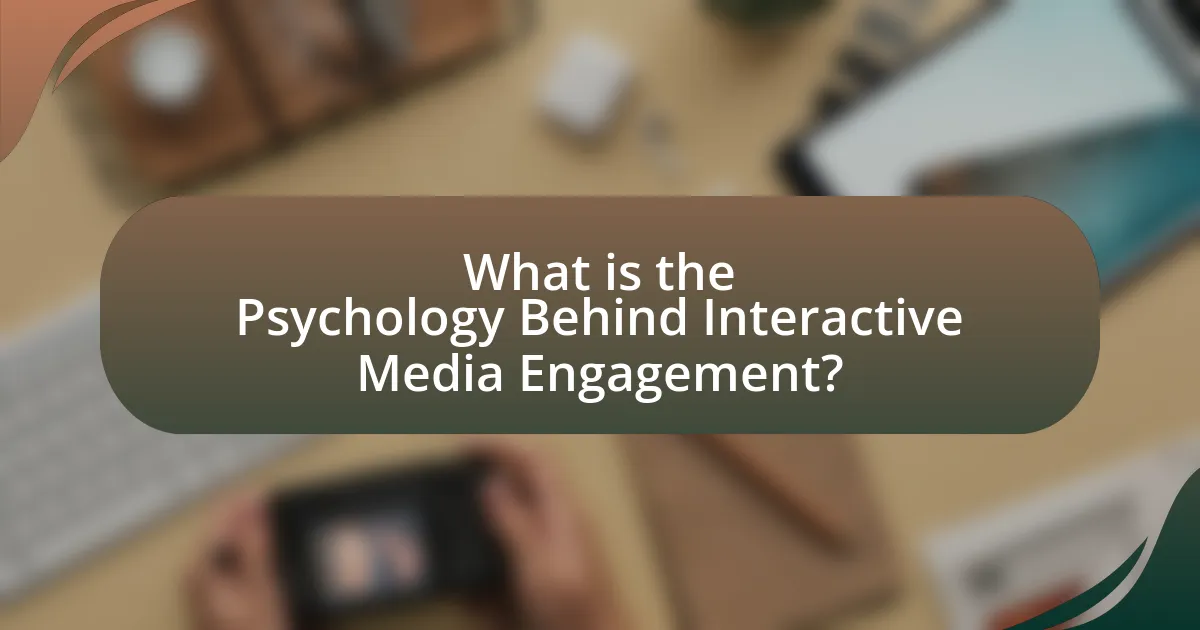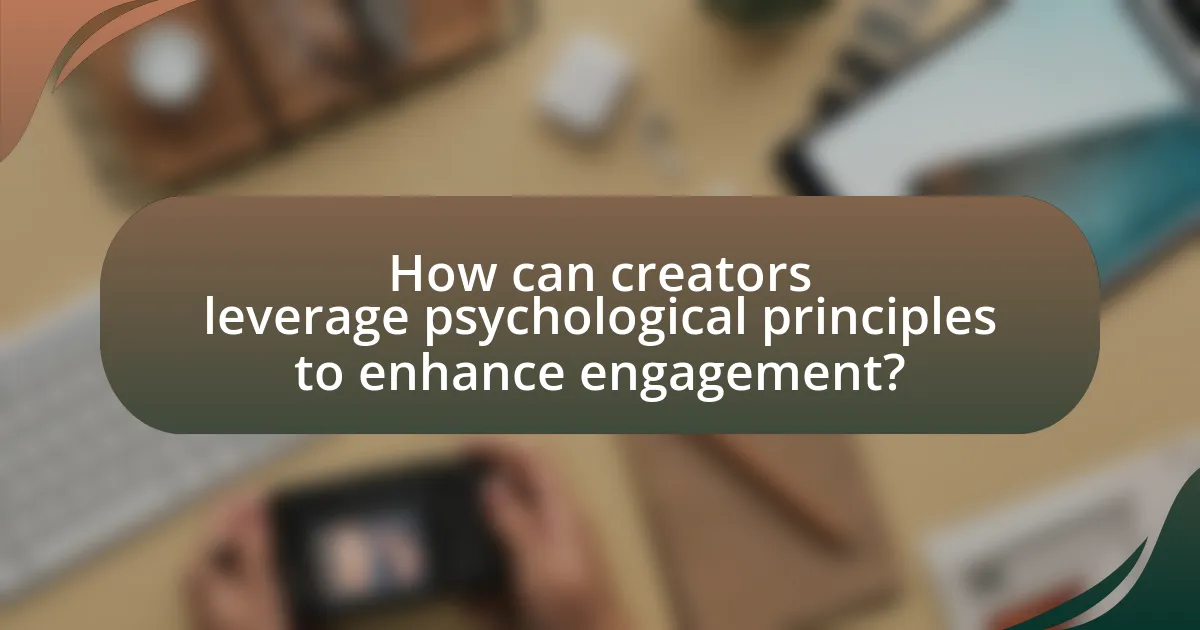The article explores the psychology behind interactive media engagement, focusing on user motivation, cognitive involvement, and emotional connection. It highlights how intrinsic motivations, such as curiosity and social interaction, drive users to engage with interactive content, while elements like feedback and choice enhance cognitive involvement. The piece discusses the influence of interactivity, personalization, and emotional resonance on user behavior, emphasizing the importance of psychological principles in media design. Additionally, it addresses the role of narrative and community in fostering engagement, as well as best practices for creators to enhance user experience through effective design and responsiveness to feedback.

What is the Psychology Behind Interactive Media Engagement?
The psychology behind interactive media engagement centers on the principles of user motivation, cognitive involvement, and emotional connection. Users are driven to engage with interactive media due to intrinsic motivations such as curiosity, the desire for social interaction, and the need for self-expression. Research indicates that interactive elements, such as feedback and choice, enhance cognitive involvement by allowing users to actively participate rather than passively consume content. For instance, studies show that gamification techniques, which incorporate game-like elements into non-game contexts, significantly increase user engagement by tapping into users’ competitive instincts and providing a sense of achievement. Furthermore, emotional connection plays a crucial role; users are more likely to engage with content that resonates with their personal experiences or evokes strong feelings, as evidenced by findings from the Journal of Media Psychology, which highlight the impact of emotional storytelling on user retention and interaction rates.
How does interactive media influence user behavior?
Interactive media significantly influences user behavior by enhancing engagement through interactivity, personalization, and immersive experiences. Research indicates that users are more likely to participate and retain information when they can interact with content, as demonstrated by a study published in the Journal of Educational Psychology, which found that interactive elements in digital learning environments increased student engagement and knowledge retention by up to 50%. Additionally, personalized content tailored to user preferences has been shown to improve user satisfaction and loyalty, as evidenced by a report from McKinsey & Company, which states that 71% of consumers expect companies to deliver personalized interactions. Thus, the combination of interactivity and personalization in interactive media effectively shapes user behavior by fostering deeper engagement and enhancing the overall experience.
What psychological principles are at play in interactive media?
Interactive media engages users through several psychological principles, including immersion, feedback loops, and social presence. Immersion occurs when users feel absorbed in the media experience, often enhanced by realistic graphics and sound, which can lead to increased emotional engagement. Feedback loops, such as rewards and achievements, reinforce user behavior and encourage continued interaction, as demonstrated by studies showing that gamification can significantly boost user motivation and retention. Social presence refers to the sense of being with others in a virtual environment, which can enhance user connection and engagement, supported by research indicating that social interactions in gaming can lead to stronger community bonds.
How do emotions affect engagement with interactive media?
Emotions significantly influence engagement with interactive media by shaping users’ motivations and responses. Positive emotions, such as joy and excitement, enhance user immersion and encourage prolonged interaction, while negative emotions, like frustration or anxiety, can lead to disengagement. Research indicates that emotionally charged content increases attention and retention; for instance, a study published in the Journal of Interactive Media found that users exposed to emotionally evocative narratives demonstrated higher engagement levels compared to neutral content. This demonstrates that the emotional resonance of interactive media directly correlates with user involvement and satisfaction.
Why is understanding psychology important for media creators?
Understanding psychology is crucial for media creators because it enables them to design content that resonates with audiences on an emotional and cognitive level. By grasping psychological principles, creators can effectively influence viewer behavior, enhance engagement, and foster a deeper connection with their audience. For instance, research indicates that storytelling techniques rooted in psychological theories, such as the narrative transportation theory, can significantly increase audience immersion and retention of information. This understanding allows media creators to craft experiences that not only capture attention but also motivate action, ultimately leading to more successful media outcomes.
How can psychological insights improve user experience?
Psychological insights can significantly improve user experience by tailoring interactions to align with users’ cognitive and emotional needs. Understanding principles such as cognitive load theory allows designers to create interfaces that minimize mental effort, enhancing usability. For instance, research by Sweller (1988) indicates that reducing extraneous cognitive load leads to better information retention and user satisfaction. Additionally, applying concepts from behavioral psychology, such as reinforcement and motivation, can encourage user engagement and loyalty. A study by Fogg (2009) highlights that users are more likely to return to platforms that provide positive reinforcement through rewards or feedback, thus improving overall user experience.
What role does user feedback play in shaping interactive media?
User feedback plays a crucial role in shaping interactive media by informing developers about user preferences and behaviors. This feedback allows creators to make data-driven decisions that enhance user experience, leading to increased engagement and satisfaction. For instance, a study by the Nielsen Norman Group found that user testing and feedback can improve usability by up to 50%, demonstrating the direct impact of user insights on design and functionality. By integrating user feedback, interactive media can evolve to meet the needs and expectations of its audience, ultimately fostering a more engaging and effective experience.

What are the key factors that drive engagement in interactive media?
Key factors that drive engagement in interactive media include interactivity, personalization, and social connectivity. Interactivity allows users to actively participate, enhancing their experience and investment in the content. Personalization tailors the experience to individual preferences, making the content more relevant and appealing. Social connectivity fosters community and shared experiences, encouraging users to engage with both the media and each other. Research indicates that these factors significantly increase user retention and satisfaction, as evidenced by studies showing that interactive elements can boost engagement rates by up to 50%.
How does interactivity enhance user involvement?
Interactivity enhances user involvement by actively engaging users in the content, making them participants rather than passive observers. This engagement fosters a sense of agency and personal investment, which can lead to increased emotional connection and retention of information. Research indicates that interactive elements, such as quizzes or simulations, can improve learning outcomes by up to 75% compared to traditional methods, as users are more likely to remember information they have actively engaged with. This active participation not only boosts motivation but also encourages deeper cognitive processing, resulting in a more meaningful user experience.
What types of interactivity are most effective?
Effective types of interactivity include gamification, user-generated content, and personalized experiences. Gamification enhances engagement by incorporating game-like elements, which research shows can increase motivation and participation; for instance, a study by Hamari et al. (2014) found that gamification can boost user engagement by up to 48%. User-generated content fosters community and connection, as evidenced by platforms like Instagram, where user contributions significantly enhance interaction rates. Personalized experiences, tailored to individual preferences, have been shown to improve user satisfaction and retention, with studies indicating that personalized recommendations can increase conversion rates by 10-30%.
How does user agency impact engagement levels?
User agency significantly enhances engagement levels by allowing individuals to make choices that align with their preferences and interests. When users feel they have control over their interactions, they are more likely to invest time and effort into the experience. Research indicates that higher levels of perceived agency lead to increased motivation and satisfaction, as users are more engaged when they can tailor their experiences. For instance, a study published in the Journal of Interactive Media found that participants who had the ability to customize their content reported a 30% increase in engagement compared to those with limited options. This demonstrates that user agency is a critical factor in fostering deeper engagement in interactive media.
What role does narrative play in interactive media engagement?
Narrative plays a crucial role in interactive media engagement by enhancing emotional connection and immersion for the user. Engaging narratives provide context and motivation, allowing users to relate to characters and situations, which increases their investment in the experience. Research indicates that narratives can activate the brain’s reward system, making interactions more enjoyable and memorable. For instance, a study published in the journal “Computers in Human Behavior” by Green and Brock (2000) found that participants who engaged with narrative content reported higher levels of transportation and emotional involvement, leading to greater engagement. Thus, effective narratives are essential for fostering deeper connections and enhancing the overall interactive experience.
How do storytelling techniques influence user immersion?
Storytelling techniques significantly enhance user immersion by creating emotional connections and fostering a sense of presence within the narrative. Techniques such as character development, plot structure, and sensory details engage users on cognitive and emotional levels, making them feel invested in the story. For instance, research by Green and Brock (2000) demonstrates that narrative transportation, where individuals become absorbed in a story, leads to greater emotional involvement and a stronger connection to the content. This heightened engagement results in users experiencing the narrative as if they are part of it, thereby increasing their overall immersion in interactive media.
What are the psychological effects of narrative structure on users?
Narrative structure significantly influences users’ psychological engagement by shaping their emotional responses and cognitive processing. A well-structured narrative can enhance empathy, as users identify with characters and their journeys, leading to deeper emotional investment. Research indicates that narratives with clear beginnings, middles, and ends facilitate better comprehension and retention of information, as they provide a framework that aligns with human cognitive patterns. For instance, a study by Green and Brock (2000) found that individuals exposed to narrative transportation—where they become immersed in a story—exhibit increased emotional responses and a greater likelihood of attitude change. This demonstrates that narrative structure not only captivates attention but also alters perceptions and behaviors, underscoring its profound psychological effects on users.

How can creators leverage psychological principles to enhance engagement?
Creators can leverage psychological principles to enhance engagement by utilizing concepts such as social proof, scarcity, and the principle of reciprocity. Social proof, which suggests that individuals are influenced by the actions and opinions of others, can be applied by showcasing user testimonials or highlighting popular content to encourage participation. Scarcity, the idea that limited availability increases desirability, can be implemented through exclusive content or time-sensitive offers, prompting users to engage more quickly. The principle of reciprocity, where individuals feel compelled to return favors, can be harnessed by providing valuable content or incentives, leading to increased user interaction. Research indicates that these psychological triggers significantly boost user engagement metrics, as evidenced by studies showing that social proof can increase conversion rates by up to 15%.
What strategies can be employed to increase user motivation?
To increase user motivation, strategies such as gamification, personalized experiences, and social engagement can be employed. Gamification incorporates game-like elements, such as points and rewards, which have been shown to enhance user engagement and motivation by providing clear goals and immediate feedback. Research by Deterding et al. (2011) highlights that gamification can lead to increased user participation and satisfaction. Personalized experiences, tailored to individual preferences and behaviors, can significantly boost motivation by making users feel valued and understood; studies indicate that personalization can increase user retention by up to 30%. Lastly, fostering social engagement through community features or collaborative tasks can enhance motivation, as users often derive satisfaction from social interactions and peer recognition, supported by findings from the Journal of Computer-Mediated Communication, which emphasize the importance of social presence in motivating users.
How can gamification elements boost engagement?
Gamification elements boost engagement by incorporating game-like features such as points, badges, and leaderboards into non-game contexts, which motivates users to participate more actively. Research indicates that these elements tap into intrinsic motivators, such as competition and achievement, leading to increased user interaction. For instance, a study published in the “Journal of Business Research” by Hamari, Koivisto, and Sarsa (2014) found that gamification significantly enhances user engagement by creating a sense of accomplishment and encouraging social interaction. This evidence supports the effectiveness of gamification in driving higher levels of user involvement and satisfaction.
What are effective ways to create a sense of community among users?
Effective ways to create a sense of community among users include fostering open communication, encouraging user-generated content, and organizing community events. Open communication allows users to share their thoughts and experiences, which strengthens connections. Encouraging user-generated content, such as forums or social media posts, empowers users to contribute and feel valued, enhancing their sense of belonging. Organizing community events, whether virtual or in-person, provides opportunities for users to interact and build relationships, further solidifying the community. Research indicates that communities with high engagement levels see a 50% increase in user retention, demonstrating the effectiveness of these strategies in creating a cohesive user community.
What are common pitfalls to avoid in interactive media design?
Common pitfalls to avoid in interactive media design include neglecting user experience, overcomplicating interfaces, and failing to test for accessibility. Neglecting user experience can lead to frustration, as users may find it difficult to navigate or engage with the media. Overcomplicating interfaces can overwhelm users, causing them to disengage; studies show that simpler designs enhance user satisfaction and retention. Failing to test for accessibility excludes users with disabilities, which is critical as approximately 15% of the global population experiences some form of disability. Addressing these pitfalls ensures a more effective and inclusive interactive media design.
How can overloading users with information reduce engagement?
Overloading users with information can reduce engagement by overwhelming them, leading to cognitive overload. When users encounter excessive information, their ability to process and retain relevant content diminishes, resulting in frustration and disengagement. Research indicates that cognitive overload can impair decision-making and reduce motivation to interact with content, as users may feel lost or unable to discern important information. For instance, a study published in the journal “Computers in Human Behavior” found that users exposed to high information loads reported lower satisfaction and engagement levels compared to those with manageable information. This demonstrates that a balanced information presentation is crucial for maintaining user engagement.
What are the consequences of neglecting user feedback?
Neglecting user feedback can lead to decreased user satisfaction and engagement. When developers ignore feedback, they risk creating products that do not meet user needs, resulting in higher churn rates. Research indicates that 70% of customers are more likely to remain loyal to a brand that actively seeks and responds to their feedback. Additionally, neglecting feedback can stifle innovation, as user insights often drive improvements and new features. This lack of responsiveness can ultimately harm a brand’s reputation and market position, as users may turn to competitors who prioritize their input.
What best practices can enhance the psychology of engagement in interactive media?
Best practices that can enhance the psychology of engagement in interactive media include creating immersive experiences, fostering user agency, and utilizing feedback mechanisms. Immersive experiences, such as high-quality graphics and sound, can captivate users, as evidenced by studies showing that sensory-rich environments increase emotional involvement and retention. Fostering user agency by allowing choices and personalization enhances the sense of control, which is linked to increased motivation and satisfaction. Feedback mechanisms, such as rewards and progress indicators, provide users with a sense of accomplishment and encourage continued interaction, supported by research indicating that immediate feedback can significantly boost user engagement levels.
